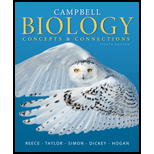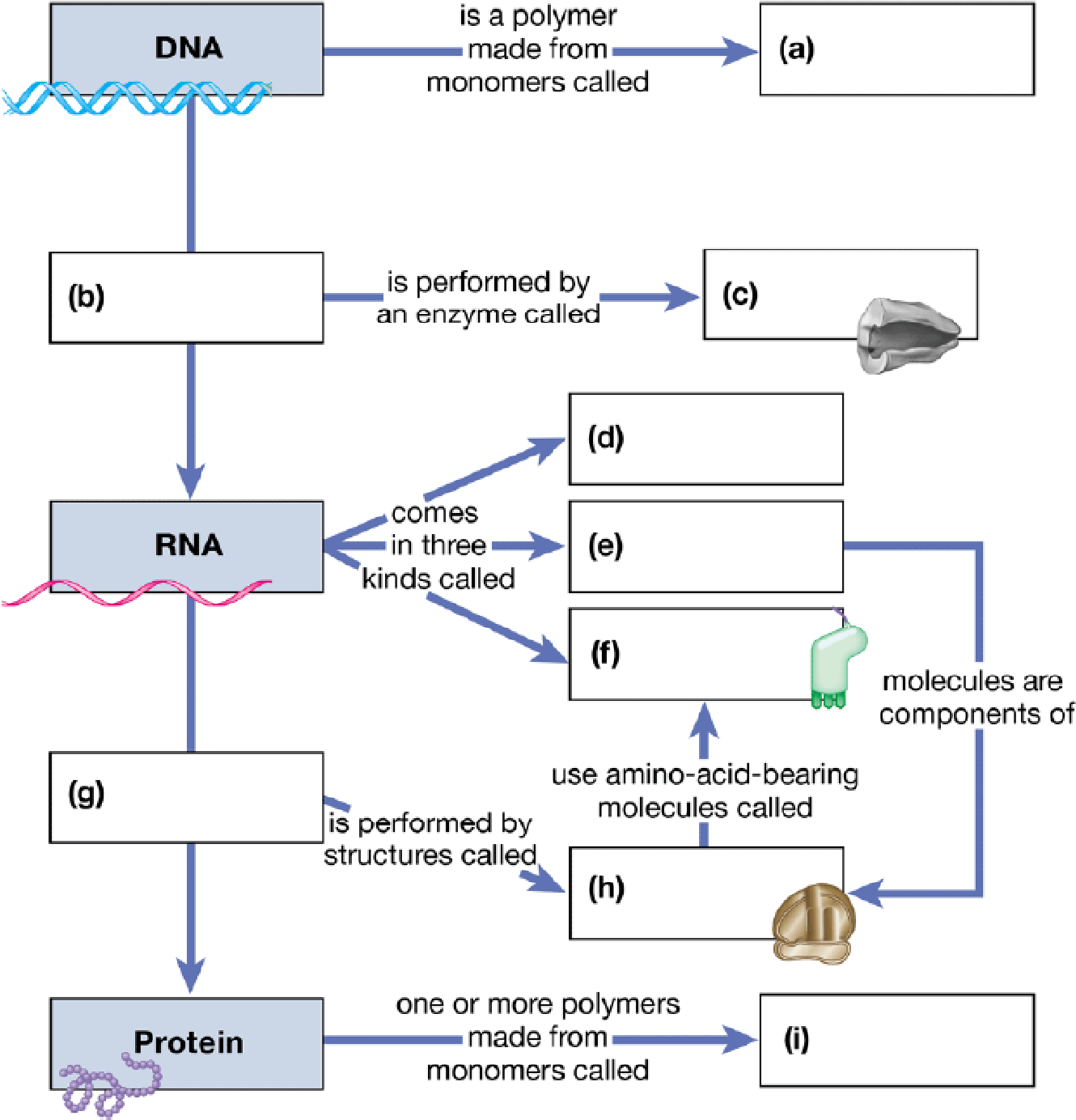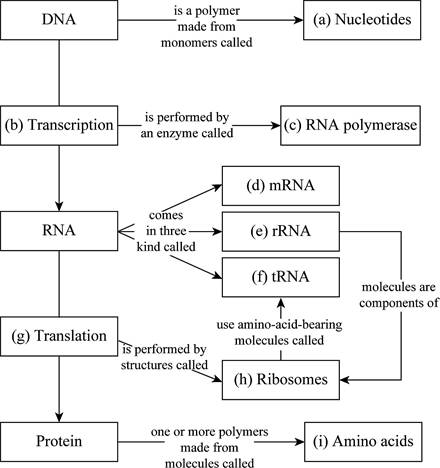
Concept explainers
Check your understanding of the flow of genetic information through a cell by filling in the blanks.

To complete: The given map showing the flow of genetic information through a cell.
Introduction: DNA is the blueprint of life. The genetic information of DNA is based in the nucleotide base sequences. These sequences are transcribed into mRNA triplets. These triplets of nucleotides are known as codons and they form the genetic code. They code for specific amino acids for the synthesis of proteins is known as functional gene products. This is known as gene expression.
Answer to Problem 1CC
Pictorial representation: Fig. 1 shows the completed map of flow of genetic information through a cell.

Fig.1 Flow of genetic information through a cell
Explanation of Solution
(a)
Correct answer: Nucleotides.
Explanation: The nucleotides are the building blocks of nucleic acids (DNA and RNA). DNA is a polymer made up of nucleotide monomers (adenine, thymine, cytosine, and guanine) and also known as polynucleotide. Hence, the correct answer is nucleotides.
(b)
Correct answer: Transcription.
Explanation: DNA consists of genetic instructions in the form of nucleotide sequences. It acts as a template and directs the messenger RNA (mRNA) synthesis in the cell. The process of formation of mRNA is known as transcription. Hence, the correct answer is transcription.
(c)
Correct answer: RNA polymerase.
Explanation: RNA polymerase enzymes are of three types out of which, RNA pol II transcribes mRNA. RNA pol II enzyme first binds to the transcription factors and then forms a complex with promoter at start codon for the beginning of transcription process. Hence, the correct answer is RNA polymerase.
(d)
Correct answer: mRNA.
Explanation: Both prokaryotes and eukaryotes consist of three types of RNA: mRNA, rRNA, and tRNA. mRNA forms 5% of the total RNA in a cell. mRNA consists of the genetic code in the form of triplets of nucleotides known as codons. Hence, the correct answer is mRNA.
(e)
Correct answer: rRNA
Explanation: rRNA forms 80% of the total RNA and is found in ribosomes. rRNAs along with proteins form ribosomes, which act as a site for protein synthesis. Hence, the correct answer is rRNA.
(f)
Correct answer: tRNA
Explanation: tRNAs are smallest among the three types of RNA. The mRNA sequence is read by transfer RNAs (tRNAs) to form polypeptide or a chain of amino acids in a process known as translation. The tRNA molecule with an attached amino acid binds to its specific mRNA codon. This mRNA codon codes for that specific amino acid. Hence, the correct answer is tRNA.
(g)
Correct answer: Translation.
Explanation: The mRNA acts as a template for the synthesis of polypeptide chain. Each letter in the gene sequence is copied which codes for a particular amino acid. The polypeptide chain is synthesized on the basis of amino acid sequences in the reading frame. This process is known as translation. Hence, the correct answer is translation.
(h)
Correct answer: Ribosomes.
Explanation: rRNAs along with proteins form ribosomes. Ribosomes act as a site of protein synthesis, that is, translation. Hence, the correct answer is ribosomes.
(i)
Correct answer: Amino acids.
Explanation: Amino acids are the monomer units of proteins. Amino acids are linked through peptide bonds to form a long polypeptide chain. Hence, the correct answer is amino acids.
Want to see more full solutions like this?
Chapter 10 Solutions
Campbell Biology: Concepts & Connections (8th Edition)
- Identify the indicated tissue? (stem x.s.) parenchyma collenchyma sclerenchyma ○ xylem ○ phloem none of thesearrow_forwardWhere did this structure originate from? (Salix branch root) epidermis cortex endodermis pericycle vascular cylinderarrow_forwardIdentify the indicated tissue. (Tilia stem x.s.) parenchyma collenchyma sclerenchyma xylem phloem none of thesearrow_forward
- Identify the indicated structure. (Cucurbita stem l.s.) pit lenticel stomate tendril none of thesearrow_forwardIdentify the specific cell? (Zebrina leaf peel) vessel element sieve element companion cell tracheid guard cell subsidiary cell none of thesearrow_forwardWhat type of cells flank the opening on either side? (leaf x.s.) vessel elements sieve elements companion cells tracheids guard cells none of thesearrow_forward
- What specific cell is indicated. (Cucurbita stem I.s.) vessel element sieve element O companion cell tracheid guard cell none of thesearrow_forwardWhat specific cell is indicated? (Aristolochia stem x.s.) vessel element sieve element ○ companion cell O O O O O tracheid O guard cell none of thesearrow_forwardIdentify the tissue. parenchyma collenchyma sclerenchyma ○ xylem O phloem O none of thesearrow_forward
- Please answer q3arrow_forwardRespond to the following in a minimum of 175 words: How might CRISPR-Cas 9 be used in research or, eventually, therapeutically in patients? What are some potential ethical issues associated with using this technology? Do the advantages of using this technology outweigh the disadvantages (or vice versa)? Explain your position.arrow_forwardYou are studying the effect of directional selection on body height in three populations (graphs a, b, and c below). (a) What is the selection differential? Show your calculation. (2 pts) (b) Which population has the highest narrow sense heritability for height? Explain your answer. (2 pts) (c) If you examined the offspring in the next generation in each population, which population would have the highest mean height? Why? (2 pts) (a) Midoffspring height (average height of offspring) Short Short Short Short (c) Short (b) Short Tall Short Tall Short Short Tall Midparent height (average height of Mean of population = 65 inches Mean of breading parents = 70 inches Mean of population = 65 inches Mean of breading parents = 70 inches Mean of population = 65 inches Mean of breading parents = 70 inchesarrow_forward
 Biology (MindTap Course List)BiologyISBN:9781337392938Author:Eldra Solomon, Charles Martin, Diana W. Martin, Linda R. BergPublisher:Cengage Learning
Biology (MindTap Course List)BiologyISBN:9781337392938Author:Eldra Solomon, Charles Martin, Diana W. Martin, Linda R. BergPublisher:Cengage Learning
 Human Biology (MindTap Course List)BiologyISBN:9781305112100Author:Cecie Starr, Beverly McMillanPublisher:Cengage Learning
Human Biology (MindTap Course List)BiologyISBN:9781305112100Author:Cecie Starr, Beverly McMillanPublisher:Cengage Learning Biology Today and Tomorrow without Physiology (Mi...BiologyISBN:9781305117396Author:Cecie Starr, Christine Evers, Lisa StarrPublisher:Cengage Learning
Biology Today and Tomorrow without Physiology (Mi...BiologyISBN:9781305117396Author:Cecie Starr, Christine Evers, Lisa StarrPublisher:Cengage Learning Human Heredity: Principles and Issues (MindTap Co...BiologyISBN:9781305251052Author:Michael CummingsPublisher:Cengage Learning
Human Heredity: Principles and Issues (MindTap Co...BiologyISBN:9781305251052Author:Michael CummingsPublisher:Cengage Learning





